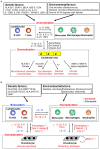Innate immune responses in Behçet disease and relapsing polychondritis
- PMID: 37435539
- PMCID: PMC10331610
- DOI: 10.3389/fmed.2023.1055753
Innate immune responses in Behçet disease and relapsing polychondritis
Abstract
Behçet disease (BD) and relapsing polychondritis (RP) are chronic multisystem disorders characterized by recurrent flare-ups of tissue inflammation. Major clinical manifestations of BD are oral aphthae, genital aphthous ulcers, skin lesions, arthritis, and uveitis. Patients with BD may develop rare but serious neural, intestinal, and vascular complications, with high relapse rates. Meanwhile, RP is characterized by the inflammation of the cartilaginous tissues of the ears, nose, peripheral joints, and tracheobronchial tree. Additionally, it affects the proteoglycan-rich structures in the eyes, inner ear, heart, blood vessels, and kidneys. The mouth and genital ulcers with inflamed cartilage (MAGIC) syndrome is a common characteristic of BD and RP. The immunopathology of these two diseases may be closely related. It is established that the genetic predisposition to BD is related to the human leukocyte antigen (HLA)-B51 gene. Skin histopathology demonstrates the overactivation of innate immunity, such as neutrophilic dermatitis/panniculitis, in patients with BD. Monocytes and neutrophils frequently infiltrate cartilaginous tissues of patients with RP. Somatic mutations in UBA1, which encodes a ubiquitylation-related enzyme, cause vacuoles, E1 enzyme, X-linked, autoinflammatory, somatic syndrome (VEXAS) with severe systemic inflammation and activation of myeloid cells. VEXAS prompts auricular and/or nasal chondritis, with neutrophilic infiltration around the cartilage in 52-60% of patients. Thus, innate immune cells may play an important role in the initiation of inflammatory processes underlying both diseases. This review summarizes the recent advances in our understanding of the innate cell-mediated immunopathology of BD and RP, with a focus on the common and distinct features of these mechanisms.
Keywords: Behçet disease; autoimmune disease; autoinflammatory disease; cytokines; macrophages; monocytes; neutrophils; relapsing polychondritis.
Copyright © 2023 Shimizu, Murayama, Mizukami, Arimitsu, Takai and Miyabe.
Conflict of interest statement
The authors declare that the research was conducted in the absence of any commercial or financial relationships that could be construed as a potential conflict of interest.
Figures


Similar articles
-
Autoimmunity and Autoinflammation: Relapsing Polychondritis and VEXAS Syndrome Challenge.Int J Mol Sci. 2024 Feb 13;25(4):2261. doi: 10.3390/ijms25042261. Int J Mol Sci. 2024. PMID: 38396936 Free PMC article. Review.
-
Unveiling the clinical spectrum of relapsing polychondritis: insights into its pathogenesis, novel monogenic causes, and therapeutic strategies.Adv Rheumatol. 2024 Apr 16;64(1):29. doi: 10.1186/s42358-024-00365-z. Adv Rheumatol. 2024. PMID: 38627861 Review.
-
Somatic Mutations in UBA1 Define a Distinct Subset of Relapsing Polychondritis Patients With VEXAS.Arthritis Rheumatol. 2021 Oct;73(10):1886-1895. doi: 10.1002/art.41743. Epub 2021 Aug 31. Arthritis Rheumatol. 2021. PMID: 33779074
-
MAGIC or not MAGIC--does the MAGIC (mouth and genital ulcers with inflamed cartilage) syndrome really exist? A case report and review of the literature.Clin Exp Rheumatol. 2006 Sep-Oct;24(5 Suppl 42):S108-12. Clin Exp Rheumatol. 2006. PMID: 17067439 Review.
-
Relapsing polychondritis: Best Practice & Clinical Rheumatology.Best Pract Res Clin Rheumatol. 2023 Mar;37(1):101867. doi: 10.1016/j.berh.2023.101867. Epub 2023 Oct 14. Best Pract Res Clin Rheumatol. 2023. PMID: 37839908 Review.
Cited by
-
Case report: Cerebral sinus vein thrombosis in VEXAS syndrome.Front Med (Lausanne). 2024 Apr 8;11:1377768. doi: 10.3389/fmed.2024.1377768. eCollection 2024. Front Med (Lausanne). 2024. PMID: 38651063 Free PMC article.
-
Ligneous periodontitis exacerbated by Behçet's disease in a patient with plasminogen deficiency and a stop-gained variant PLG c.1468C > T: a case report.BMC Oral Health. 2023 Nov 8;23(1):843. doi: 10.1186/s12903-023-03586-8. BMC Oral Health. 2023. PMID: 37940896 Free PMC article.
-
Resolution of long-lasting laryngeal manifestations using glucocorticoids and tumor necrosis factor-α inhibitor therapy in a patient with mouth and genital ulcers with inflamed cartilage syndrome.J Rheum Dis. 2025 Jul 1;32(3):225-228. doi: 10.4078/jrd.2024.0144. Epub 2025 Mar 10. J Rheum Dis. 2025. PMID: 40584762 Free PMC article.
-
A comprehensive prognostic and immune infiltration analysis of UBA1 in pan-cancer: A computational analysis and in vitro experiments.J Cell Mol Med. 2024 Aug;28(16):e70037. doi: 10.1111/jcmm.70037. J Cell Mol Med. 2024. PMID: 39183260 Free PMC article.
-
Autoimmunity and Autoinflammation: Relapsing Polychondritis and VEXAS Syndrome Challenge.Int J Mol Sci. 2024 Feb 13;25(4):2261. doi: 10.3390/ijms25042261. Int J Mol Sci. 2024. PMID: 38396936 Free PMC article. Review.
References
Publication types
LinkOut - more resources
Full Text Sources
Research Materials
Miscellaneous

